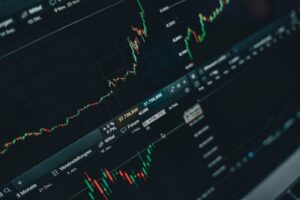1.Introduction:
Forex trading, short for foreign exchange trading, is a global marketplace that stands as one of the most dynamic and accessible financial markets in the world. Each day, trillions of dollars change hands as currencies are bought and sold, making forex trading a source of unparalleled opportunity and volatility. As a trader, your journey in this realm begins with a comprehensive understanding of the market, the strategies available, and the factors that drive currency valuations. This introduction serves as your gateway into the multifaceted world of forex trading, offering an overview of what you can expect to explore further in this comprehensive guide.
- The World of Forex Trading
The forex market is the largest and most liquid financial market globally, facilitating the exchange of currencies used by nations across the world. Its size and accessibility make it a preferred arena for traders of all backgrounds, from individual retail traders to institutional investors. As a place where global currencies are traded around the clock, it presents abundant opportunities for profit and investment.
- The Significance of Forex Trading
Forex trading is significant for a multitude of reasons. It plays a pivotal role in facilitating international trade and commerce, as well as in managing currency risk for businesses and governments. For individual traders, it offers the potential for financial growth and a level of accessibility that wasn’t previously available in traditional financial markets. However, it’s also marked by risks that necessitate a thorough understanding of the market and its intricacies.
- Navigating Your Forex Journey
To navigate the world of forex trading successfully, one must delve into various aspects, including trading strategies, analysis techniques, risk management, and trading psychology. This guide will explore these topics comprehensively, providing you with insights, strategies, and best practices to aid you in your quest for success in the forex market.
As you embark on your forex trading journey, remember that education, discipline, and continuous learning are your most potent allies. The forex market is a dynamic and ever-evolving ecosystem, and this guide aims to equip you with the knowledge and tools needed to navigate its complexities and seize its potential for profit and financial growth. Whether you are a beginner looking for a solid foundation or an experienced trader seeking to refine your strategies, the information provided here will serve as your guide through the exciting world of forex trading.
2.Understanding Technical Analysis:
Technical analysis is a foundational aspect of forex trading, and comprehending its principles is essential for traders seeking to make informed decisions in the dynamic currency market. At its core, technical analysis involves the examination of historical price data to forecast future price movements. To delve into the realm of technical analysis effectively, it’s crucial to explore its core principles and tools, as well as its strengths and weaknesses.
- Define Technical Analysis:
At its essence, technical analysis is the process of examining past price data and trading volumes to forecast future price movements. Traders who employ this method believe that historical price movements and patterns can provide insights into the probable direction of currency pairs. Technical analysis hinges on the idea that price trends tend to persist, and by identifying these trends, traders can anticipate potential entry and exit points.
- Core Principles and Tools of Technical Analysis:
Price Charts: Price charts serve as the foundation of technical analysis. These charts visually represent historical price data, showcasing the open, close, high, and low prices for each trading period. Common chart types include candlestick charts, line charts, and bar charts.
Patterns: Technical analysts examine price charts to identify recurring patterns, such as head and shoulders, double tops, and flags. These patterns may signal potential price reversals or continuations, providing traders with insights for decision-making.
Indicators: Technical indicators are quantitative tools applied to price data to offer additional insights. Common indicators include moving averages, Relative Strength Index (RSI), and the Moving Average Convergence Divergence (MACD). These indicators help traders gauge market momentum and overbought or oversold conditions.
- Strengths and Weaknesses of Technical Analysis:
Technical analysis comes with distinct strengths and weaknesses. Its strengths lie in its systematic approach and visual interpretation, offering traders a straightforward and intuitive way to assess market trends and patterns. It provides traders with tools to make precise timing decisions for entries and exits.
However, it also has limitations. Critics argue that technical analysis may not consider external factors like economic events or geopolitical developments that can significantly influence currency values. Additionally, since it relies on historical patterns, there’s no guarantee that these patterns will always repeat, making it somewhat subjective. Traders must use technical analysis in conjunction with other forms of analysis and risk management techniques to enhance their decision-making process.
In the world of forex trading, technical analysis serves as a valuable tool for traders, aiding in identifying potential opportunities and making informed trading decisions. By understanding its core principles, tools, and recognizing its strengths and weaknesses, traders can navigate the complexities of the forex market with a more comprehensive understanding of market dynamics and trends.
Understanding Fundamental Analysis:
Fundamental analysis is a cornerstone of forex trading, offering traders a distinct perspective on the market that complements technical analysis. To fully comprehend the essence of fundamental analysis, one must delve into its core principles and tools, as well as appreciate its strengths and limitations.
- Define Fundamental Analysis:
At its core, fundamental analysis is the process of evaluating currencies based on economic, financial, and geopolitical factors that can influence their value. Unlike technical analysis, which focuses on price data, fundamental analysis delves into the underlying forces that drive currency valuations. Traders employing this method seek to understand the intrinsic or fair value of a currency by examining a wide range of factors.
- Core Principles and Tools of Fundamental Analysis:
Economic Indicators: Economic indicators, such as GDP growth, employment data, inflation rates, and trade balances, serve as critical metrics. Traders analyze these indicators to gauge the overall health and stability of a nation’s economy, as well as potential future monetary policy decisions.
Interest Rates: Central banks set interest rates, which can significantly impact currency values. Higher interest rates often attract foreign investment, leading to an appreciation of the currency. Traders closely monitor central bank policies and interest rate changes.
Geopolitical Events: Events like elections, trade agreements, geopolitical conflicts, and major policy shifts can have an immediate and profound impact on currency values. Traders keep a watchful eye on global events that might affect the forex market.
- Strengths and Weaknesses of Fundamental Analysis:
Fundamental analysis offers several strengths. It provides a holistic and long-term perspective on the forex market, allowing traders to understand the underlying factors driving currency movements. It can be particularly valuable for investors with longer investment horizons. Unlike technical analysis, fundamental analysis accounts for real-world events and economic conditions that can shape currency values.
However, fundamental analysis also has its challenges. It requires a deep understanding of economic and geopolitical factors, making it less suitable for short-term traders who may focus on technical analysis. Additionally, fundamental analysis may not always provide precise timing for market entry or exit, as it deals with more gradual and long-term trends.
Fundamental analysis remains indispensable for traders and investors looking to understand the broader market context and anticipate currency trends over longer horizons. While both technical and fundamental analysis have their places in the forex market, the integration of fundamental analysis into a trader’s toolkit provides a more comprehensive understanding of market dynamics and the forces that influence currency values. By recognizing the strengths and limitations of fundamental analysis, traders can make informed decisions that align with their trading goals and timeframes.
Choosing the Right Strategy for You:
Selecting the appropriate trading strategy in the complex world of forex is a pivotal decision that can significantly influence your success in the currency market. The right strategy should align with your trading goals, risk tolerance, and the unique aspects of your trading personality. Here, we’ll explore the factors to consider when making this critical choice.
- Assessing Your Trading Goals and Personality:
Trading Goals: The first step in choosing the right strategy is defining your trading goals. Are you looking for quick, short-term profits, or are you more inclined towards long-term investing? Your objectives will significantly impact your choice of strategy.
Risk Tolerance: Consider your risk tolerance. Are you comfortable with market volatility and uncertainty, or do you prefer a more conservative and risk-averse approach? Your risk tolerance will influence the type of strategy you should pursue.
Trading Personality: Your trading personality is a vital factor. Are you patient and disciplined, or do you tend to be impulsive and emotional when making trading decisions? Understanding your personality traits can help you select a strategy that matches your behavioural tendencies.
- Analysing Market Conditions:
Market conditions can vary significantly, and the suitability of different strategies can change accordingly. It’s essential to adapt your strategy to the current market environment. Consider the following factors when analysing market conditions:
Trending vs. Range-Bound Markets: Are you in a trending market with clear upward or downward movements, or is the market range-bound with prices moving within a defined range? Different strategies work better in these distinct conditions.
Economic Events: Be aware of upcoming economic events and news releases that can impact currency values. Some traders may prefer to avoid major news events, while others actively trade around them.
- Combining Technical and Fundamental Analysis:
While technical and fundamental analysis are often seen as separate approaches, some traders choose to combine elements of both. This fusion can provide a more comprehensive view of the market. For example, you might use technical analysis for short-term entry and exit points and fundamental analysis to understand the broader market context and anticipate longer-term trends.
Ultimately, the right strategy should be a reflection of your unique financial goals, risk tolerance, and trading personality. Keep in mind that there’s no one-size-fits-all approach to trading in the forex market. The key to success is not just in selecting a strategy but also in continuous learning, discipline, and risk management. As you gain experience, your strategy may evolve, and you’ll adapt to changing market conditions. Regardless of the strategy you choose, remember that education and a well-defined plan are your allies on your journey to success in forex trading.
Case Studies:
In the world of forex trading, learning from the experiences of successful traders can provide invaluable insights and inspiration. Case studies of accomplished forex traders not only illustrate the potential rewards of trading but also shed light on the strategies and principles that have contributed to their success. These real-life examples serve as a source of guidance for both aspiring and experienced traders, showcasing how traders have navigated the complexities of the forex market and achieved their financial goals. Here are a few case study examples that demonstrate the diverse paths to success in forex trading:
George Soros and the Pound Short: Perhaps one of the most famous case studies in forex trading history, George Soros’s bet against the British Pound in 1992, known as “Black Wednesday,” netted him a profit of over $1 billion. Soros’s success was built on a combination of astute fundamental analysis, a deep understanding of economic factors, and the courage to take a significant short position in the currency.
Paul Tudor Jones and the 1987 Crash: Paul Tudor Jones, a renowned hedge fund manager, made substantial profits during the 1987 stock market crash. His use of technical analysis and the application of risk management techniques helped him weather the volatile market conditions, showcasing the significance of adaptability and risk control.
Linda Bradford Raschke – The Trading Wizard: Linda Bradford Raschke is a notable female trader known for her impressive track record. Her success is attributed to a combination of technical analysis, discipline, and the development of her unique trading strategies, which emphasises trend following and risk management.
John Taylor – FX Concepts: John Taylor, the founder of FX Concepts, was a pioneer in forex trading, using both technical and fundamental analysis to manage billions in assets. His success was built on a combination of quantitative models and understanding the macroeconomic drivers of currency movements.
These case studies illustrate that there is no one-size-fits-all approach to forex trading success. Traders can employ various strategies, timeframes, and analytical methods, but certain commonalities, such as discipline, risk management, and continuous learning, run through all their stories. By studying these case studies and others, traders can gain a deeper understanding of the multifaceted nature of forex trading and apply the lessons learned to enhance their own trading endeavours. Additionally, these real-life examples highlight the importance of patience and perseverance in the pursuit of financial goals in the forex market.
Conclusion:
As we conclude our exploration of the fascinating world of forex trading, it becomes abundantly clear that this financial market offers both unparalleled opportunities and unique challenges. Whether you are a novice trader looking to build a solid foundation or an experienced trader seeking to refine your strategies, the knowledge and insights gained from this guide are invaluable in your quest for success.
Forex trading is a dynamic and ever-evolving ecosystem where market conditions can shift rapidly, and risk and uncertainty are ever-present companions. The strategies discussed, whether technical or fundamental, should not be seen as mutually exclusive but rather as complementary tools that can enhance your trading acumen. The choice of strategy depends on your trading goals, risk tolerance, and the market conditions you face.
Throughout this guide, we’ve emphasised the importance of continuous learning, discipline, and effective risk management. The journey of a forex trader is marked by a commitment to adaptability, as the market continually presents new opportunities and challenges. Your education is a lifelong endeavour, and the willingness to learn from both successes and setbacks is what sets successful traders apart.
Remember that while success in forex trading is attainable, it is not guaranteed. The market can be unpredictable, and no strategy is foolproof. However, by remaining patient, disciplined, and committed to improving your trading skills, you can position yourself for success and navigate the complexities of the forex market.
In the world of forex trading, as in life, the journey is as valuable as the destination. Each trade is a learning experience, and each day in the market offers a chance for growth and refinement. Your success ultimately depends on your ability to adapt, manage risk effectively, and make well-informed decisions.
With this knowledge in hand, you are better prepared to embark on your forex trading journey with confidence. May your endeavours be profitable, your learning experiences abundant, and your trading career marked by wisdom and success. Happy trading!




